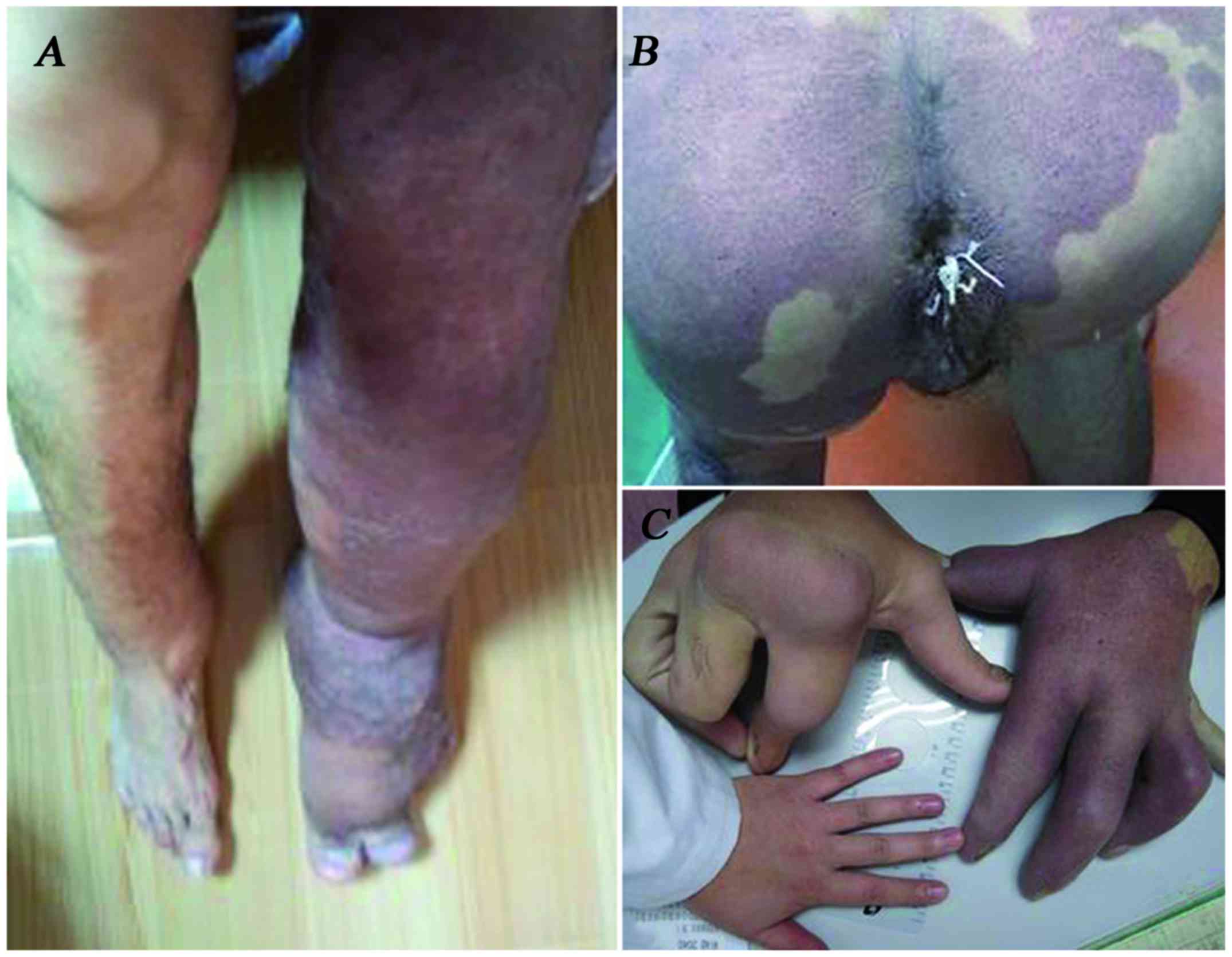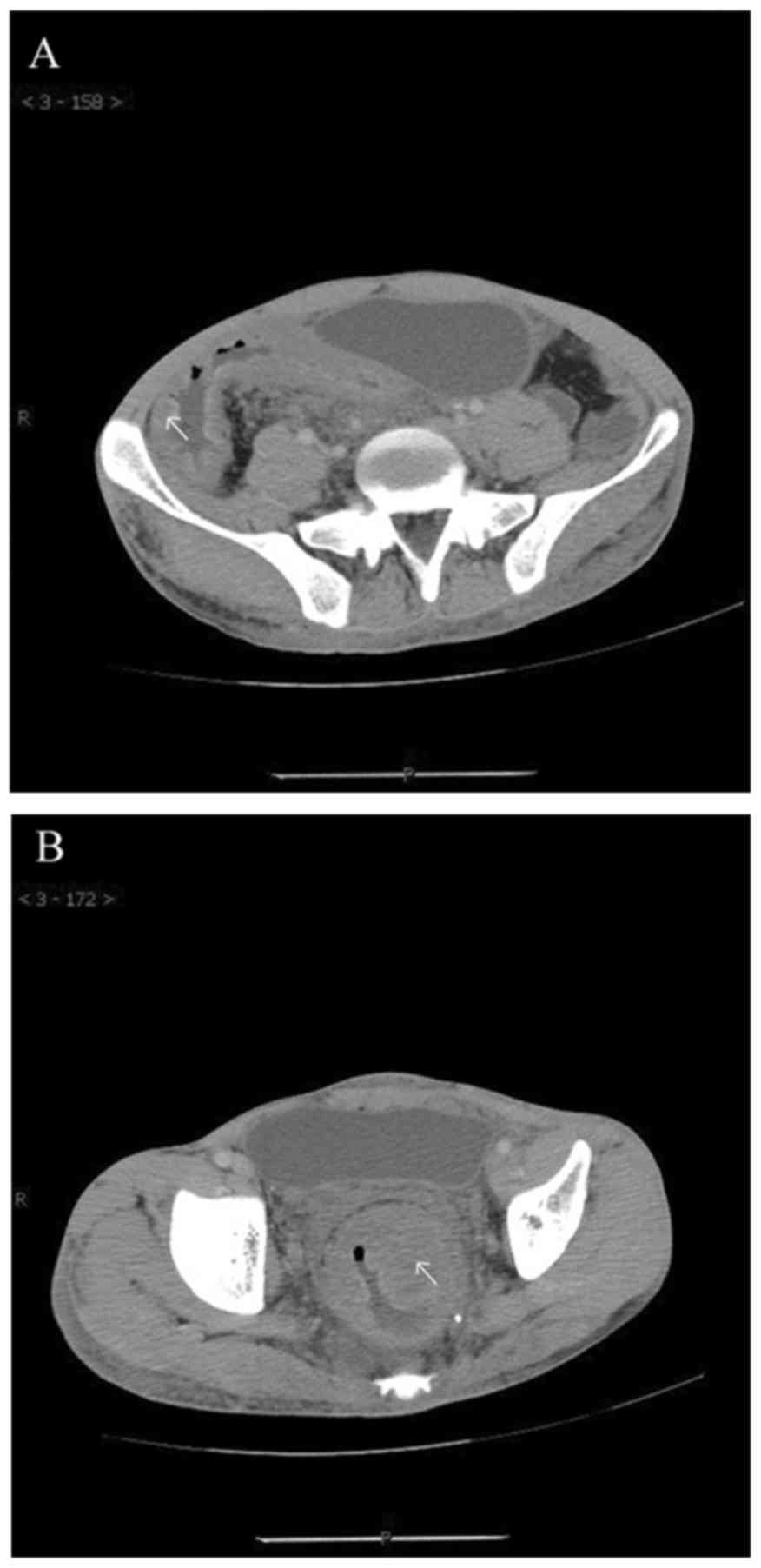Proteus syndrome: A case report and review of the literature
- Authors:
- Published online on: January 23, 2017 https://doi.org/10.3892/mco.2017.1140
- Pages: 381-383
Abstract
Introduction
Proteus syndrome is an extremely rare complex disorder characterized by patchy or mosaic postnatal overgrowth of different body parts (1). Proteus syndrome was first described by Cohen and Hayden in 1979 (2), with an estimated prevalence of <1/1,000,000 live births (3,4). The onset may involve any site of the body and typically occurs during infancy. The severity of Proteus syndrome has been found to vary among different affected individuals, and commonly affected tissues include the skin, connective tissue and bone, central nervous system and eye (5). The affected tissues vary widely regarding the extent of the involvement and the severity in different patients, and they may be divided into four main categories, namely soft tissue tumors, vascular anomalies, macrodactyly and histopathological characteristics (6). The etiology of Proteus syndrome has not been fully elucidated, but somatic genetic alterations, such as AKT somatic mutations, in the affected tissue may be the major causative factor. This is the case report of a Chinese male patient with Proteus syndrome, with a review of the literature on the molecular pathology underlying this disorder.
Case report
A 34-year-old man was admitted to Shenzhen People's Hospital for treatment of progressive postnatal overgrowth and skin problems mainly involving the limbs and hip. The patient's parents had observed asymmetric overgrowth of the lower limbs during childhood, but no systemic treatment was performed. On physical examination, there was an obvious discrepancy in the length of the legs; in addition, the left lower limb was enlarged and covered by an irregular red-brown plaque (Fig. 1A). Asymmetric growth of the upper limbs was also observed, with the right forearm, which was covered by an irregular epidermal nevus, being larger compared with the left forearm. The structure of the right hand was also clearly affected and the middle and index fingers could not be freely extended; in addition, certain areas of the neck, abdomen and back were covered by a red-brown irregular plaque with hyperpigmented borders (Fig. 1B and C); subcutaneous lipomas were also present. Affected tissue samples were collected from the patient's back for further molecular biological analysis by whole-exome sequencing, as previously described (7). Briefly, the whole exome of affected and control tissues was analyzed by high-throughput sequencing. Quality control and basic filtering were performed, and the 90-bp paired-end sequence reads were aligned and used for variant calling. A total of 381 variants were found after the variants were filtered. However, no mutation reportedly associated with the Proteus syndrome was identified. The patient also presented with hematochezia, and a multislice spiral CT revealed multiple hemangioma-like lesions of the large intestinal mucosa and systemic vascular disease (Fig. 2). The patient refused surgery due to the high cost of the treatment and the associated surgical risk, and symptomatic treatment was instead administered to control the skin and gastrointestinal symptoms. The treatment included topical mupirocin for a concurrent infection of the skin lesions on the left lower limb, and oral levofloxacin for the gastrointestinal problems. On the last follow-up, in November 25, 2016, the condition of the patient remained stable; the skin and gastrointestinal symptoms were partly controlled and there was no obvious disease progression.
Written informed consent was obtained from the patient regarding the publication of the case details and associated images.
Discussion
The exact cause of Proteus syndrome remains unclear, although AKT1 mutations were recently identified as an important cause of this uncommon disease. The Proteus syndrome is a relative rare and complex disease, which is characterized by partial gigantism of the limbs, lipomas, varicosities and verrucous epidermal nevi. After this type of disease was first reported in 1979 (2), similar cases were described by Wiedemann et al in 1983 (8); however, only a limited number of cases of the Proteus syndrome have been reported to date. The treatment of Proteus syndrome is challenging, and multiple orthopedic procedures have been attempted in the clinical setting to control abnormal overgrowth; however, patients with this syndrome may suffer severe cosmetic and functional consequences, even with aggressive treatment (4).
Although diagnostic criteria for the Proteus syndrome have been established, the variable phenotype may be a major cause of misdiagnosis. According to the diagnostic criteria revised by Turner et al in 2004 (9), each of the general criteria and some of the specific criteria should be present to establish the diagnosis of Proteus syndrome. In the present case, the diagnosis of the Proteus syndrome was based on the presence of 3 of the major criteria, namely mosaic distribution of the lesions, sporadic occurrence and progressive course; and 5 of the specific criteria, namely disproportionate overgrowth of the left leg and epidermal nevi on some areas of the neck, abdomen and back (category B), lipomas, venous malformation and facial phenotype (category C).
Given the high complexity of the clinical characteristics of the Proteus syndrome, the hypothesis of somatic mosaicism underlying this syndrome is important. Based on this hypothesis, Proteus syndrome may develop from certain postzygotic mutations. It was recently indicated that mutations causing dysfunction of the phosphoinositide 3 kinase (PI3K)-AKT pathway, such as phosphatase and tensin homolog (PTEN) and AKT1 mutations, may be important causes of the Proteus syndrome (10). However, there is a controversial association between PTEN mutations and the clinical characteristics of the Proteus syndrome, and certain affected individuals harboring somatic PTEN mutations and clinical characteristics such as segmental overgrowth, lipomatosis, arteriovenous malformation and epidermal nevi, were diagnosed with the SOLAMEN or the Cowden syndromes (11,12). Considering the clinical characteristics and gene function of PTEN, these three syndromes may belong to the same class of disorders. In 2011, Biesecker (4) identified the genetic basis of Proteus syndrome through analysis of 12 samples of exomes obtained from 6 patients with Proteus syndrome using exome sequencing; additional cases of validation confirmed that somatic mutations in AKT1 were an important cause of Proteus syndrome (10). However, no mutation in the reported Proteus syndrome-associated genes, including AKT1, PTEN or PIK3CA, was found by exome sequencing in our case, which was similar to 3 of the 29 individuals with Proteus syndrome described by Biesecker. It is likely that some mutations in unknown genes may contribute to the development of Proteus syndrome, but further investigation is required.
Considering the severe complications of the Proteus syndrome, it is necessary to diagnose this disorder earlier in childhood, and remain alert regarding potential tumor development in such patients, in order to improve their quality of life. In addition, in the majority of patients, Proteus syndrome may be caused by mutations in certain known genes, and genetic examination of the family members of patients with the syndrome may be performed, which may prove to be valuable for variant filtering and identification of disease-related mutations.
In summary, Proteus syndrome is a relatively recently described and complex disease with a variable phenotype, and its diagnosis is challenging. Although AKT1 mutations have been identified as a cause of Proteus syndrome, the precise pathogenesis and etiology of this syndrome require further investigation.
Acknowledgements
The present study was funded by the Science and Technology Innovation Commission of Shenzhen Municipality (grant nos. JCYJ20130401093116730 and JCYJ20150403101146277), and the Guangxi Natural Science Foundation (grant no. 2015GXNSFBA139176).
References
|
Cohen MM Jr: Proteus syndrome review: Molecular, clinical, and pathologic features. Clin Genet. 85:111–119. 2014. View Article : Google Scholar : PubMed/NCBI | |
|
Cohen MM Jr and Hayden PW: A newly recognized hamartomatous syndrome. Birth Defects Orig Artic Ser 15(5B). 291–296. 1979. | |
|
Furquim I, Honjo R, Bae R, Andrade W, Santos M, Tannuri U and Kim C: Proteus syndrome: Report of a case with recurrent abdominal lipomatosis. J Pediatr Surg. 44:E1–E3. 2009. View Article : Google Scholar : PubMed/NCBI | |
|
Biesecker L: The challenges of Proteus syndrome: Diagnosis and management. Eur J Hum Genet. 14:1151–1157. 2006. View Article : Google Scholar : PubMed/NCBI | |
|
Alves C, Acosta AX and Toralles MB: Proteus syndrome: Clinical diagnosis of a series of cases. Indian J Endocrinol Metab. 17:1053–1056. 2013. View Article : Google Scholar : PubMed/NCBI | |
|
Hoey SE, Eastwood D, Monsell F, Kangesu L, Harper JI and Sebire NJ: Histopathological features of Proteus syndrome. Clin Exp Dermatol. 33:234–238. 2008. View Article : Google Scholar : PubMed/NCBI | |
|
Sui W, Ou M, Liang J, Ding M, Chen J, Liu W, Xiao R, Meng X, Wang L, Pan X, et al: Rapid gene identification in a Chinese osteopetrosis family by whole exome sequencing. Gene. 516:311–315. 2013. View Article : Google Scholar : PubMed/NCBI | |
|
Wiedemann HR, Burgio GR, Aldenhoff P, Kunze J, Kaufmann HJ and Schirg E: The proteus syndrome. Partial gigantism of the hands and/or feet, nevi, hemihypertrophy, subuutaneos tumors, macrocephaly or other skull anomalies and possible accelerated growth and visceral affections. Eur J Pediatr. 140:5–12. 1983. View Article : Google Scholar : PubMed/NCBI | |
|
Turner JT, Cohen MM Jr and Biesecker LG: Reassessment of the Proteus syndrome literature: Application of diagnostic criteria to published cases. Am J Med Genet A. 130:111–122. 2004. View Article : Google Scholar | |
|
Lindhurst MJ, Sapp JC, Teer JK, Johnston JJ, Finn EM, Peters K, Turner J, Cannons JL, Bick D, Blakemore L, et al: A mosaic activating mutation in AKT1 associated with the Proteus syndrome. N Engl J Med. 365:611–619. 2011. View Article : Google Scholar : PubMed/NCBI | |
|
Caux F, Plauchu H, Chibon F, Faivre L, Fain O, Vabres P, Bonnet F, Selma ZB, Laroche L, Gérard M and Longy M: Segmental overgrowth, lipomatosis, arteriovenous malformation and epidermal nevus (SOLAMEN) syndrome is related to mosaic PTEN nullizygosity. Eur J Hum Genet. 15:767–773. 2007. View Article : Google Scholar : PubMed/NCBI | |
|
Loffeld A, McLellan NJ, Cole T and Moss C: Type 2 segmental Cowden disease vs. Proteus syndrome: Reply from authors. Br J Dermatol. 158:410–411. 2008.PubMed/NCBI |











